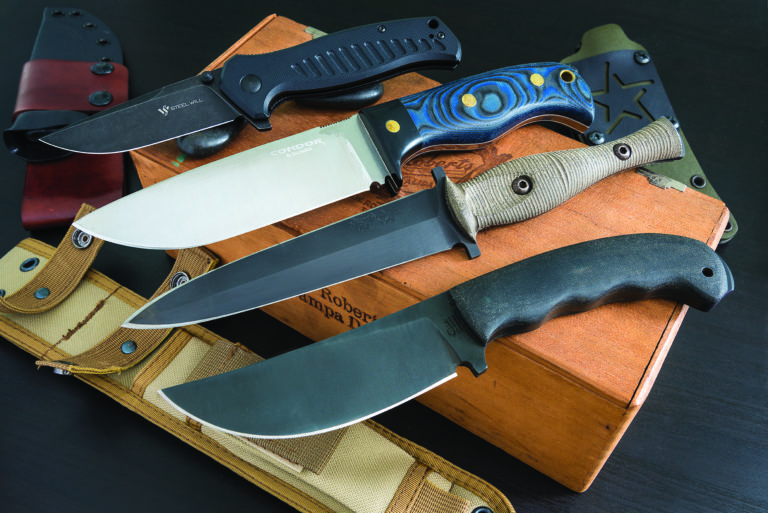
Carbon steel knives continue to be among the top factory performers.
High-performance stainless steels—CPM S30V, S35VN, S90V and 20CV, along with CPM 154, M390 and CTS 204P, to name some— rule in many corners of today’s knife market. While such steels exhibit astonishing edge-holding power and the ability to go the distance without much maintenance, the tradeoff is they can be difficult to sharpen. With the ascendance of such “super steels” you might think carbon steels would be gone for good.
Nothing could be further from the truth. While carbon steels may not attract the attention they once did, that doesn’t mean they’re no less a viable option for hunting, camping and even tactical knives. Many still prefer carbon steels over the high-performance stainless ones, and the primary reason is ease of sharpening, especially in the field. While carbon steels require a bit more maintenance, such as a light coat of oil to prevent corrosion and staining, they can give premium stainless steels a run for the money. Another factor is the all-important lower cost of carbon steels.
SANDBOX STEEL: A.G. Russell Knives Sandbox Dagger
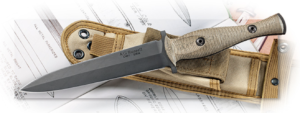
The inspiration for the Sandbox Dagger from A.G. Russell Knives comes straight from the old Camillus Marine Raider Stiletto and legendary Fairbairn-Sykes dagger, both of World War II fame. BLADE Magazine Cutlery Hall-Of-Fame® member A.G. Russell’s intent was to recreate the effectiveness of the venerable dagger designs while boosting the durability of the blade, as the tapered, relatively thin blades were prone to break. Carefully studying the old combat knives, A.G. devised the Sandbox Dagger.
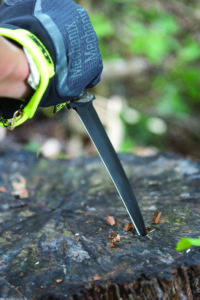
Beginning with a wider blade that takes longer to taper, thus giving it more body, he discovered new ways of grinding that allowed more stock thickness to remain, enhancing lateral strength. Traditionally a weak spot for daggers, the point thickness is more considerable as well. Another A.G. idea was to offer a “varied edge angle.” Most of the blade would be sharpened at A.G.’s preferred angle of 15 degrees, but toward the tip it changes to a more obtuse angle to bolster point strength. Phil Gibbs, company design engineer, was in charge of torture testing prototypes. One of the tests he successfully performed was driving the dagger through an AK-47 magazine, with absolutely no damage to the tip, and the edge remaining very sharp.
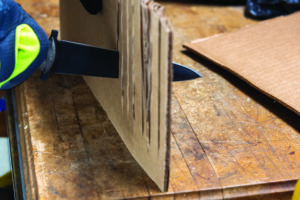
The 6-inch blade is DM1 steel, named in honor of bladesmith/metallurgist Dan Maragni, who assisted in its development and heat treatment for A.G. Russell Knives. It is a modified version of the 0170-6C carbon steel the old Camillus used when it made the Becker Knife & Tool line. (Today, KA-BAR makes all BK&T knives.) DM1 can sustain hard use without edge deformation or chipping, yet remains easy to resharpen.
The ergonomic handle is green, rib-textured Rucarta. The rounded handle expands toward the tang to better fit your hand. Indentations on either side give your thumb a non-slip resting place for grip retention, as well as a reference point for blade indexing. The blade is razor sharp out of the box. Manufacturer’s suggested retail price (MSRP): $375.
A-R-RMY, SIR! Case Hambone
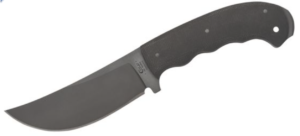
Knifemaker Daniel Winkler and U.S. Army veteran Clint Romesha (page ??) designed the Case Hambone to be a “do-all” field knife for field dressing, batonning wood, preparing food and more. Hambone was the nickname of the legendary U.S. Army pack mule Hamilton T. Bone. Hambone was based at Fort Carson, Colorado, as part of the pack mule program and served from 1943-56, including two combat missions during World War II—the same base Romesha operated from during his military career.
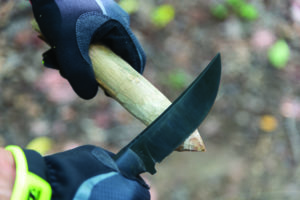
Hambone the knife embodies the hardworking spirit of Hambone the pack mule. The 80CrV2 carbon steel is tough and holds an edge. The trailing point/skinner blade is 4.75 inches with a full flat grind and generous belly that facilitate chores like slicing and chopping/batonning. Handle material options are black canvas Micarta®, curly maple and black textured rubber. The finger-grooved handle with a bird’s-beak butt and integral guard ensures a secure grip in most conditions.
The eight stars engraved on the handle spine memorialize Romesha’s eight teammates who gave their lives during the Battle of Kamdesh in Afghanistan (page ??). The exposed blade tang can be employed as a hammer or glass breaker. The felt-lined Kydex sheath promotes sure knife retention and easy deployment equally well. Rather than having a typical fold-over or sandwich construction, the sheath uses a Micarta spacer to separate its Kydex halves. The OD green Kydex features black overlay with a star laser cut into it to symbolize the Army’s colors and logo.
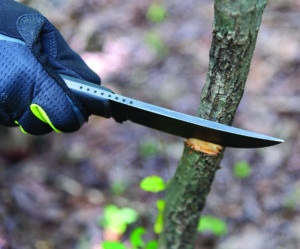
The Hambone’s deep blade belly is great for cutting meats and vegetables. The blade is fairly thick up to the tip, which makes it strong for heavy use and abuse. The handle is quite comfortable, providing ample blade control at all times, even with wet hands. The Micarta material is an excellent choice for an all-around user.
The only downside might be the weight. Some may find the knife too heavy on a belt, but, then again, the weight is one of the contributing factors to its cutting power. MSRPs: $325.99 (black canvas Micarta), $333.99 (curly maple) and $342.99 (textured rubber).
TACTICAL CLASSIC: Steel Will Barghest

The Steel Will Barghest has all the hallmarks of a great tactical folder. The test model’s modified clip-point blade of 3.5 inches is full-flat ground from D2 tool steel, a favorite among production companies and custom makers for its toughness and ease of sharpening. The blade opens via a flipper or ambidextrous thumb studs, and the swedge grind adds a bit of attitude. The action is quick, smooth and precise, with the blade riding on a pair of phosphor bronze washers.
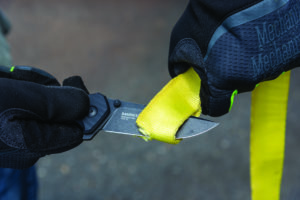
The handle is a study in the perfect tactical folder design well suited for prolonged use regardless of the elements. The integral guard prevents your hand from slipping forward, and the handle gracefully curves and expands slightly at the midsection to fill your palm nicely without feeling too unwieldy. The blade secures via a linerlock, and dual steel liners provide rigidity. Black G-10 scales feature a series of machined grooves that enhance your grip with or without gloves. A pronounced chamfer on the edges of the scales makes the Barghest feel very comfortable, eliminating any hot spots. A fold-over steel pocket clip carries the knife deep in a pocket. Steel Will also offers a second clip for lefties—just switch clips. The G-10 handle spacer sports large traction notches, and is slightly oversized to make the notches stand out.
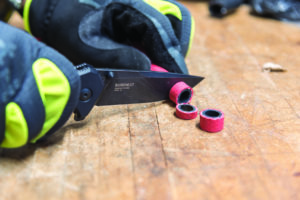
The Barghest offers what I like in a tactical folder. The blade shape and size is ideal for many cutting tasks, not too small nor too large, and has plenty of bite to power through a variety of tough materials. D2 is a time-proven steel that withstands abuse yet is easy to maintain.
The only negative I see is the pocket clip. Yes, it is a positive as well, but not everyone likes the deep-carry feature, as no part of the handle sticks above the pocket to grab onto. Hence, you must fish around a bit to grab the knife. Hey, you can’t please everyone! MSRPs: $84.99 (3.5-inch blade) and $89.99 (4-inch blade).
STOUT as it is SOLID: Condor Tool & Knife Blue Havoc
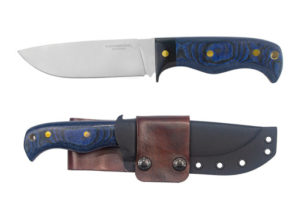
The Condor Tool & Knife Blue Havoc features a 5.5-inch drop-point blade of 1075 carbon steel mated to two-tone black-and-blue paper Micarta scales and a black phenolic bolster. The knife is a handful, a beast that can tackle any cutting task at camp or, in a pinch, use for combat. It is stout as it is solid. The satin-finished blade’s full flat grind is aces in cutting efficiency. A series of traction notches filed into the blade spine provide optimal positioning for applying downward pressure for tougher cutting tasks.
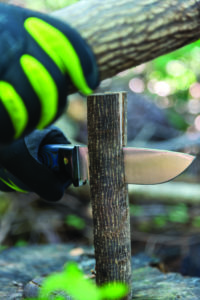
The handle sports a generous palm swell that fills your grip comfortably, is non-slip and offers precise blade control. Micarta is an excellent choice for using knives because it is strong yet lightweight. It is impervious to most fluids and isn’t affected by weather changes, humidity, heat or most any external factor that would cause integrity issues. Plus, it comes in a myriad of hues to please the pickiest knife enthusiast. The dual-color Micarta® layers show through, adding an exciting visual texture, more so than any solid color Micarta can offer. Integral front and rear guards prevent unwanted hand movement in either direction, and the front guard enables you to choke up to exercise control for precise cutting. As big as the knife is, it’s important that it be able to tackle finer cutting as well, especially in a camp or survival scenario.
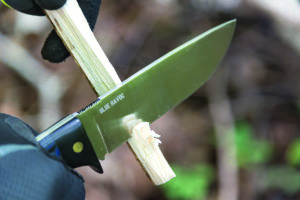
The Blue Havoc’s sheath materials are an unusual mix: molded Kydex and a leather belt loop. Most Kydex sheaths usually have either a Kydex belt loop or some sort of quick-release attachment, such as a Blade-Tech Tek-Lok. The reason Condor went with the leather belt loop on a Kydex sheath is to allow you to remount the belt loop in the event the sheath orientation must be reversed to accommodate left-hand/side-body carry. Simply remove/replace two screws to dismount/remount the loop. Also, the leather allows the entire sheath to move on your belt to a degree to prevent the knife from being caught up in bushes, branches, etc.
Condor’s catalog states the Blue Havoc can be used in either a tactical or outdoor setting, though due to its appearance, the knife is probably better suited for outdoor use. Moreover, the drop-point blade shape makes it a great camp utility knife for food prep or field dressing/skinning tasks. The 1075 carbon steel resharpens very well, which helps at the campsite. MSRP: $134.98.
STILL RELEVANT
Carbon steel is alive and well at a time when super steels are all the rage. It remains the steel of choice of many hardcore knife users, not only for the lower cost but primarily for the ease of sharpening. It may require a bit more maintenance than stainless, but carbon steel is still relevant and here to stay.
 NEXT STEP: Download Your Free KNIFE GUIDE Issue of BLADE Magazine
NEXT STEP: Download Your Free KNIFE GUIDE Issue of BLADE Magazine
BLADE’s annual Knife Guide Issue features the newest knives and sharpeners, plus knife and axe reviews, knife sheaths, kit knives and a Knife Industry Directory.Get your FREE digital PDF instant download of the annual Knife Guide. No, really! We will email it to you right now when you subscribe to the BLADE email newsletter.






